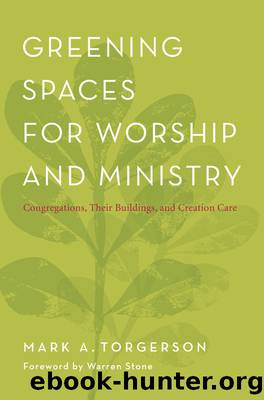Greening Spaces for Worship and Ministry by Torgerson Mark A.;

Author:Torgerson, Mark A.; [Mark Torgerson]
Language: eng
Format: epub
Tags: Religion
ISBN: 1674089
Publisher: Rowman & Littlefield Unlimited Model
Published: 2012-04-05T00:00:00+00:00
Unity Temple Unitarian Universalist Congregation
Oak Park, Illinois
www.unitytemple.org, www.unitytemple-utrf.org
National Historic Landmark, 1970
Unity Church, originally established as an independent liberal congregation, was founded in the village of Oak Park near Chicago in 1871.8 In time the church affiliated with the Unitarian denomination. In 1961 Unity Church became the Unitarian Universalist Church in Oak Park. In 1994 the congregation united with Beacon Unitarian Church, Oak Park, to become Unity Temple Unitarian Universalist Congregation. The congregation includes about five hundred people today. The Reverend Alan Taylor is the present senior pastor. The church is located on a long and narrow lot (approximately four-tenths of an acre) on a busy corner.
In 1905 the original building for Unity Temple was destroyed by fire, and the community decided to rebuild. They selected an architect familiar with their congregation, Frank Lloyd Wright (1867â1959), to design the new building. Wright had become an innovative and recognized architect by the turn of the century. He was developing a contemporary style of design that would come to be called âprairie style.â In keeping with the spirit of Unitarianism, Wright sought to create a meeting place for the faith community to gather, worship, and work that was focused on the divine among people. The overall design of the church features two primary spaces: a space for public worship, Unity Temple, and a space for social service, Unity House. A spacious entry hall joins the two spaces. Offices, classrooms, and various meeting rooms are found in the buildings. Wright also designed interior features, including light fixtures, windows, and skylights for the buildings. The worship space is nearly thirty feet high and has seating for 345 people, with seats distributed over three levels on three sides of the central pulpit area. No worshiper is more than forty-five feet away from the speaker. Clerestory windows (some of which can be opened for natural ventilation) and laylights (with skylights above them for weather protection), displaying Wrightâs abstract glass designs, allow much natural light into the space.
Unity Temple was built between 1906 and 1908 for about $60,000 (one-third over the original budget). The prairie-style building emphasizes the horizontal plane over the vertical, incorporates large overhangs, uses limited angular ornamentation on the exterior, and includes integrated plantings. Poured-in-place concrete (with steel reinforcement) was the primary building material for the project, an emerging material and process for public buildings at that time. In both design and material choice, Unity Temple was a significant departure from traditional ecclesiastical architecture. Unity Temple was recognized as an early pioneer in modern American church design. Its significance was acknowledged through its inclusion on the National Register for Historic Places as a National Historic Landmark in December 1970.
New, untested building materials and processes inevitably provide maintenance challenges over time. The poured concrete of Unity Temple has yielded cracks and failed to maintain its integrity through the years. No expansion joints were included in the design, and the flat roofs have been found to have inadequate drainage systems. Water has taken a significant toll on the building.
Download
This site does not store any files on its server. We only index and link to content provided by other sites. Please contact the content providers to delete copyright contents if any and email us, we'll remove relevant links or contents immediately.
Kathy Andrews Collection by Kathy Andrews(11676)
The remains of the day by Kazuo Ishiguro(8738)
Paper Towns by Green John(5022)
Spare by Prince Harry The Duke of Sussex(4993)
The Body: A Guide for Occupants by Bill Bryson(4881)
Industrial Automation from Scratch: A hands-on guide to using sensors, actuators, PLCs, HMIs, and SCADA to automate industrial processes by Olushola Akande(4839)
Machine Learning at Scale with H2O by Gregory Keys | David Whiting(3961)
Be in a Treehouse by Pete Nelson(3875)
Harry Potter and the Goblet Of Fire by J.K. Rowling(3736)
Never by Ken Follett(3701)
Goodbye Paradise(3665)
Into Thin Air by Jon Krakauer(3261)
The Remains of the Day by Kazuo Ishiguro(3253)
The Cellar by Natasha Preston(3218)
The Genius of Japanese Carpentry by Azby Brown(3188)
Fairy Tale by Stephen King(3155)
120 Days of Sodom by Marquis de Sade(3114)
Drawing Shortcuts: Developing Quick Drawing Skills Using Today's Technology by Leggitt Jim(2960)
The Man Who Died Twice by Richard Osman(2953)
